|
|
|
Nov. 2, 2023
Stay informed! Here?s a summary of upcoming wildlife and habitat management activities and ways you can discover, explore and experience Minnesota?s outdoors.
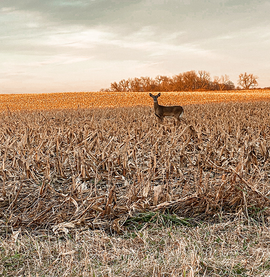
Make a plan for deer season
Firearms deer season is this weekend! More than 400,000 deer hunters are preparing for the firearms deer season that opens Saturday, Nov. 4. We?re reminding all deer hunters to plan ahead for a safe and enjoyable hunt. The DNR?s online?make a plan tool?provides a comprehensive step-by-step list of information hunters need to consider before heading to deer camp. The tool covers topics including hunting regulations, deer processing, chronic wasting disease sampling, safety and how to make the most out of a hunt.
Are you a newer hunter or just want to brush up on the skills you?ll need once you?ve successfully harvested a deer? Check out our learn to deer hunt videos that include how-to field dress, skin and quarter a deer. You can also watch a recorded?webinar all about the 2023 deer season.
And if you?re using a CWD mail-in kit to take a lymph node sample, there?s an instructional video on the?DNR website. Other sampling instructions, test results and more can be found on the?DNR CWD page.
Photo courtesy of Clayton Cozad
|
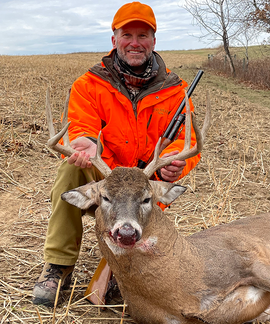
Hunters: Register your deer
Hunters are required to register every deer they harvest before processing, before antlers are removed and within 48 hours after taking the animal.
Hunters can register deer online, via phone or in person. Information from deer registration is essential for the DNR to track and manage deer populations. Detailed registration instructions for all methods are available on the DNR website.
Photo courtesy of?Tim Sletten
|
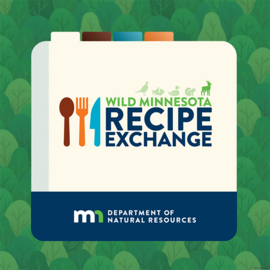
Share your venison recipes
Calling all deer hunters! Do you have a favorite venison recipe? Share it with the Minnesota DNR by Thursday, Nov. 30, for a chance to be featured on our website, social media and other publications.
Recipes can carry special meaning. They?re passed down generations and are central to cultural traditions. And some are special because they just taste darn good. Wild game meals give hunters a chance to fully appreciate their harvest, share with friends and family, and connect with nature on a deeper level.
It?s easy to share your venison recipe. Visit the DNR website to submit your recipe online. Remember to submit it by Nov. 30 for your chance to be featured.
|

Here?s a way to share your deer hunting photos
We?d love to see your photos from deer camp. It?s easy to share them via our photo uploader for the chance to see them in DNR email updates, social media and our website.
We welcome photos of any aspect of hunting you?d like to share like landscapes, deer harvests, chickadees, deer camp or high fives. And please make sure hunters have on the required blaze clothing and are safely handling firearms.
Photo courtesy of?Kelly Winston
|
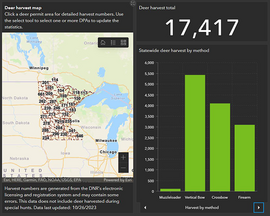
Deer harvest numbers available online
Hunters, media and anyone interested in statewide deer harvest data can find current deer harvest figures and harvest reports for past years on the Minnesota Department of Natural Resources deer reports and statistics page.
The page also features an interactive map and graphs that visualizes the data including numbers on how many deer have been harvested by muzzleloaders, vertical bows, crossbows and firearms.
|

Be careful with heat sources that cause sparks
Whether skies are cloudy, sunny or a bit snowy, Minnesota?s fire danger can change quickly in the fall as vegetation dries out. Check conditions and be careful with any heat source that can cause a spark. Make sure campfires are out cold before you leave and park vehicles ? including ATV/OHVs?? away from grass or vegetation, where hot exhaust systems can spark a wildfire. Find current conditions on the fire danger and burning restrictions page.??
|

Answers to some last-minute hunting questions
It?s go time! As you pack for deer camp, we?ve collected a few of the questions and answers we have been hearing ahead of firearms deer season.
Can I use a drone to track a deer I shot?????
No. Drones cannot be used to take big game and this includes tracking deer.
How much blaze orange do I need on the top of my ground blind when I am hunting on public land?
The regulations don?t give a certain size when using blaze on top of a blind on public land, but it does have to be visible from all directions, or be a patch made of blaze orange material that is at least 144 square inches (12 by 12 inches) on each side of the blind.?
My child didn?t harvest a deer during the youth deer season. Is their license still valid during the firearms deer season?
Yes, they can use their unfilled youth firearms license during the November firearms season. They don?t have to purchase a new firearms license.
|
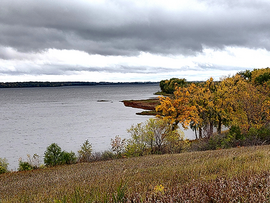
Share your input on Lac qui Parle WMA master plan
The Minnesota DNR is asking people interested in the Lac qui Parle Wildlife Management Area to share their perspectives about future management at the WMA. The Lac qui Parle WMA master plan was last updated in 1997, and it is important for this update to reflect current public values and attitudes about how the land should be managed.
An online questionnaire is available on the Engage with DNR website through Wednesday, Nov. 8. The questionnaire is also available in Hmong?and in Spanish.?
Written comments may also be submitted by emailing?[email protected] or sending mail to Lac qui Parle WMA, 14047 20th St. NW, Watson, MN 56295.
Additional public input opportunities will be available in the spring of 2024 as a draft plan is developed including draft goals, objectives and strategies. More about Lac qui Parle WMA can be found on Minnesota DNR website.
Photo courtesy of?Terri Dinesen
|
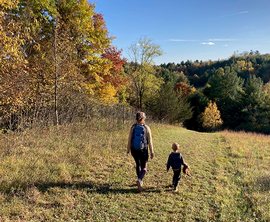
DNR grants help children get outside, begin a lifetime of outdoor experiences
The Minnesota DNR is pleased to announce another phase of the No Child Left Inside grants. These grants help more children cast a line, study animal tracks, hike or bike, or simply learn more about nature. Public entities and nonprofit organizations serving youth younger than 18, including Native American tribes, schools or governments, can apply for No Child Left Inside grants.
The Minnesota DNR is accepting applications for both mini grants (less than $5,000) and larger grants ($5,000 to $25,000). The request for proposals, application instructions and contact information for questions can be found on the?DNR website. Applications will be accepted until 2 p.m. Tuesday, Dec. 12.
|
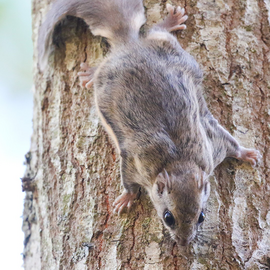
Wildlife highlight: flying squirrels
Minnesota is home to two species of flying squirrels! The two species are the northern flying squirrel (which prefer northern coniferous forests) and the southern flying squirrel (which prefer southern hardwood forests).
Flying squirrels cannot technically fly ? they glide! The honor of the only flying mammal goes to bats.
If you?ve never seen a flying squirrel, it might be because they?re primarily nocturnal. Flying squirrels are frequent visitors to birdfeeders at night. Both species are omnivores. They?ll eat a variety of fruits and nuts, insects, small birds and meat scraps. Flying squirrels do not hibernate, but slow their body activity in winter and sometimes nest in groups to stay warm. Learn more about flying squirrels in Minnesota.
Photo of a southern flying squirrel courtesy of Mark Faherty, iNaturalist
|
|
|
|
|
Get hunting information
Find hunting and trapping regulations, harvest registration, how to contact a conservation officer and information about pursuing a variety of species at the DNR hunting webpage. New to hunting? Check out the DNR learn to hunt guides.
Have?Minnesota wildlife?or?deer hunting photos?to share? Upload your photos so we can share them in DNR email updates, social media and our website.
|
|
|
|
